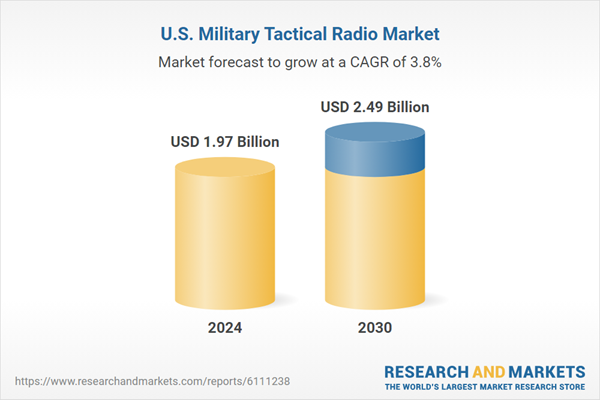U.S. Military Tactical Radio Market Trends
The U.S. military tactical radio market size was estimated at USD 1.97 billion in 2024 and is projected to grow at a CAGR of 3.8% from 2025 to 2030. The market growth is driven by the increasing need for secure and reliable communication systems across defense operations, especially in dynamic and hostile environments. Rising defense budgets, modernization of battlefield communication infrastructure, and growing demand for real-time situational awareness are fueling the adoption of advanced tactical radios.In addition, technological advancements such as software-defined radios (SDRs), multi-band capabilities, and integration with satellite communication systems are enhancing operational efficiency. Ongoing military modernization programs and the need for interoperable systems among allied forces are also contributing significantly to market expansion in the coming years.
The growth of the U.S. military tactical radio industry is primarily driven by the increasing demand for agile, programmable, and multi-mission communication capabilities. Software-defined radios (SDRs) offer enhanced flexibility by enabling real-time updates and support for multiple waveforms, reducing the need for hardware replacements. As joint operations and coalition missions become more prevalent, the U.S. military is adopting SDRs to achieve greater interoperability across branches and allied forces. This shift is expected to significantly accelerate industry innovation and procurement activity over the forecast period.
The U.S. military tactical radio industry is experiencing rapid growth due to the critical need for secure and resilient communication systems in modern conflict environments. As electronic warfare and cyber threats escalate, encrypted radios capable of anti-jamming and low probability of intercept/detection (LPI/LPD) are in high demand. The Department of Defense is increasingly investing in secure tactical communications to safeguard mission-critical information and maintain information superiority. These efforts are driving vendors to integrate advanced cryptographic protocols directly into tactical radio platforms.
Energy-efficient tactical radios are gaining traction in the U.S. military tactical radio industry due to increasing mission duration and operational demands. Extended battery life and power optimization are critical to ensuring uninterrupted communications in austere environments. Manufacturers are developing systems with low power draw, quick recharge capabilities, and adaptive energy management features. These advancements not only reduce the logistical burden but also enhance mission sustainability and combat readiness.
The need for seamless cross-border communication in multinational operations is a strong growth driver for the U.S. military tactical radio industry. Interoperability with NATO and allied systems has become essential, requiring radios to support common waveforms and frequency bands. Military forces are procuring radios that can operate on shared standards to enhance operational coordination and mission success in joint exercises and real-world deployments. This trend is compelling for vendors to develop versatile solutions with robust coalition-ready communication capabilities.
The rising demand for advanced radio solutions in armored platforms such as MRAPs and command vehicles is enabling mobile command and control capabilities on the move. These tactical radios are engineered to withstand high-speed, rugged environments while delivering secure, high-bandwidth communication under heavy electronic interference. With multi-band and multi-channel functionalities, military vehicles are evolving into mobile communication hubs essential for network-centric warfare. This demand is closely tied to the Army and Marine Corps’ modernization priorities, compelling industry players to develop hardened, vehicle-optimized communication systems.
U.S. Military Tactical Radio Market Report Segmentation
This report forecasts revenue growth at country levels and provides an analysis of the latest technological trends in each of the sub-segments from 2018 to 2030. For this study, the analyst has segmented the U.S. military tactical radio market report based on type, frequency, technology, application, and end use:Type Outlook (Revenue, USD Million, 2018 - 2030)
- Handheld Radio
- Manpack Radio
- Vehicle-Mounted Radio
- Base Station Radio
- Airborne Radio
- Naval Radio
Frequency Outlook (Revenue, USD Million, 2018 - 2030)
- Very High Frequency (VHF)
- Ultra-High Frequency (UHF)
- High Frequency (HF)
- Others (Multiband, SHF,EFH)
Technology Outlook (Revenue, USD Million, 2018 - 2030)
- Conventional Radios
- Software-Defined Radios (SDR)
Application Outlook (Revenue, USD Million, 2018 - 2030)
- Command & Control Communication
- Surveillance & Reconnaissance
- Electronic Warfare
- Others
End Use Outlook (Revenue, USD Million, 2018 - 2030)
- Army
- Navy
- Air Force
Why should you buy this report?
- Comprehensive Market Analysis: Gain detailed insights into the global market across major regions and segments.
- Competitive Landscape: Explore the market presence of key players worldwide.
- Future Trends: Discover the pivotal trends and drivers shaping the future of the global market.
- Actionable Recommendations: Utilize insights to uncover new revenue streams and guide strategic business decisions.
This report addresses:
- Market intelligence to enable effective decision-making
- Market estimates and forecasts from 2018 to 2030
- Growth opportunities and trend analyses
- Segment and regional revenue forecasts for market assessment
- Competition strategy and market share analysis
- Product innovation listing for you to stay ahead of the curve
- COVID-19's impact and how to sustain in these fast-evolving markets
This product will be delivered within 1-3 business days.
Table of Contents
Companies Mentioned
- Raytheon Technologies (RTX Corporation)
- General Dynamics Corporation
- L3Harris Technologies
- Northrop Grumman Corporation
- Motorola Solutions, Inc.
- ViaSat Inc.
- FLIR Systems, Inc. (now part of Teledyne Technologies)
- ITT Corporation
- BAE Systems
- Thales Group
- Leonardo S.p.A.
- Elbit Systems Ltd.
Table Information
| Report Attribute | Details |
|---|---|
| No. of Pages | 70 |
| Published | June 2025 |
| Forecast Period | 2024 - 2030 |
| Estimated Market Value ( USD | $ 1.97 Billion |
| Forecasted Market Value ( USD | $ 2.49 Billion |
| Compound Annual Growth Rate | 3.8% |
| Regions Covered | United States |
| No. of Companies Mentioned | 12 |









